The Glencar Cycle Route
Glencar cycle route is not a cycling adventure for those of you who might believe that exercise is a thing of the devil, created to bring a glimpse of the pains of hell to earth. Equally it is not for the fitness fanatic who does a similar cycle like this before breakfast, as a warm up for the two triathlons that have to be completed before evening dinner.
This trip is Leitrim at it's best.
The Glencar Cycle Route caters for the the reasonably fit person who loves getting out in the country fresh air, who wants to 'feel' the countryside they are passing and who wants a pace that will suit them on what they know is going to be a long day's enjoyment.
It is for those who want to stop and take a photograph of particular things that hit a note, things that they alone might think fascinating and above all, it is for those who want to forget totally about the stresses and cares of work now left far behind them. (That said, the moment you dismount at the cycle's completion, it's likely the possibility of demonic involvement in exercise might have some validity).
There are any amount of absolute best and unique scenic spots in all of Ireland on this journey, so let us assume that W.B.Yeats made a slight error by not including Leitrim when he described Sligo as his "Land of Hearts Desire".
If you are reading this in your house or apartment in Central Europe, Asia, Antarctica or indeed in a seedy bar in the backwoods of Neptune, surrounded by hostile Venetians, this route sounds like it was created for you. Please try and get a copy of, or download Yeats's earlier poems before travelling, in particular "The Stolen Child", purely to appreciate the subtleties of Glencar.
Sligo to Glencar
Before we start, a bicycle would be useful for the journey so, Sligo town can provide us with everything necessary from Sligo Bike Hire +353 87 637 7999, or Chain Driven Cycles +353 71 912 9008, or Gary's Cycles + 353 71 913 8060. These shops offer a range of bikes for all ages and skill levels, as well as helmets and other safety equipment to ensure a safe and enjoyable ride. Once you have everything, a few nibbles and a bottle of water are required and then off we go.
Leaving Sligo take the N16 and leisurely head in the direction of the Dartry Mountains. Should you have read the above-mentioned poem, let it run through your head on this 14km section of the cycle until, up in front on the slope of the first hill, will be seen what looks like a small dark green forest with a brown clutch of trees in it's center in the shape of a Celtic design. From here on begins the part of the journey where the true magic of the county takes over.
The magic referred to was presented to the world by Yeats and covers about a 15 mile radius from Sligo town. A lot of his earlier revelations about the relationship between humanity and the Otherworld are revealed his poetry which was inspired by this region. Many of the towns and villages within this radius are mentioned and none more researched than Glencar, from where the Stolen Child disappeared.
Glencar, as the name suggests, is a glen with two rivers and two waterfalls feeding it. One of the falls, called Sruth in Aghaidh an Ard (or the Devil's Chimney) occurs when the Little People decide that the salmon population needs more water to play in. The waterfall concerning us, however, is the other one Glencar waterfall.
Glencar Waterfall
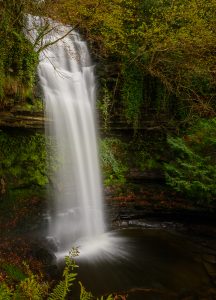 This falls is not especially high or wide, it is no Niagara, Victoria, or Blue Nile waterfall but, what ignites our imagination is the collective sight of a background created by nature specifically for this waterfall. It combines the constant subtle change of light on the surrounding varied foliage, the seemingly hand carved flat layered rock, almost supported by a rock column on one side while hanging greenery decorates the other and the sound of cascading music adds to the mesmerizing scene. It is easy to imagine mysterious guardians slumbering in the dark recesses of the backdrop.
This falls is not especially high or wide, it is no Niagara, Victoria, or Blue Nile waterfall but, what ignites our imagination is the collective sight of a background created by nature specifically for this waterfall. It combines the constant subtle change of light on the surrounding varied foliage, the seemingly hand carved flat layered rock, almost supported by a rock column on one side while hanging greenery decorates the other and the sound of cascading music adds to the mesmerizing scene. It is easy to imagine mysterious guardians slumbering in the dark recesses of the backdrop.
The poem, therefore, shows us a visual image of old Irish folklore in a perfect location. Combine this with the fact that Yeats chose this beauty spot in the center of a ten mile radius of beauty to reveal to us the exact place, by a waterfall, where fairies gave a child an option.
The child, watching and listening to the water, could either take the fairies hand, go with them where they would weave old dances to and fro, leap, with one jump onto frothy bubbles at the seas of Rosses point, look for slumbering trout to whisper in their ear at Glencar lake, watch herons disturb drowsy water rats from Slish Woods and know where the fairy vats were, full of the reddest stolen cherries or, (some option!) stay in the world the he currently lived in, full of troubles and inexplicable weeping's so far unknown to him.
In modern terms, a no brainer.
Perhaps, however, the child was not given the option at all- poor lad. Perhaps it is the reader, you, that Yeats is talking to, despite the poem being written so long ago.
By the age of twenty-one Yeats' thoughts on life forms on Earth were muddling around in his mind as were his thoughts on how advanced industrialisation was impacting the world. The ever deepening fascination he had for the ancient folklore and heroes of ancient Ireland that he knew meant less than nothing to the ideals of the country's new ruler- this he thought was down to the intransigence and greed of world thinking.
There is no doubt, he was a deep thinker and that poetry would be his way of expressing his thoughts but in a manner us lesser mortals could, at some stage, relate to.
Yeats and Glencar
The collective interests, institutions and thinking of what he termed "shoddy West Brit" society showed clearly in the neglect and perhaps distain with which they regarded Irish writing and culture. Yeats' thoughts were full of the boyhood folk tales told to him in his beloved Sligo from which was born his particular technique of expressing opinion and feeling of both his and his countries "Irishness". His way of writing did not include oppressive influences of England's bad, mediocre or great poets.
In Dublin he was introduced to William Morris who was giving a talk at the Contemporary Club of which Yeats was a member. This proved to be beneficial to the Irishman later in London in 1887. That was when Yeats re-introduced himself to Morris and was well received.
As it happened Morris had a focused interest in Irish affairs and was himself interested in ancient Irish poetry and how the Irish language would use a more flowery way of describing something by talking of its surroundings like" Sruth in aghaidh an Ard" - flow in the face of height - for a waterfall. Morris was also taken by the heroical and mythological tales as they aligned to his own idea of a medieval world not trampled on by mass machinery production. Morris' way of saying commercialisation is killing our ability to enjoy nature for what it is.
This all fell neatly into the "unmuddling" of some of the swirling thoughts occupying Yeats' head.
Could it be therefore, that even at an early age William Butler Yeats was able to tell even us today of a way to unwind from the constant barrage of contemporary stresses and the incessant need to be entertained. Through the honest and, in truth, indescribable beauty of nature he uses a poem to draw us into the mind of a young boy, in a place that matches the magic of the poetry.
After the falls it will be of no surprise to you to hear that a stones throw from here, from a strong arm, is another waterfall, the above mentioned Sruth in Aghaid an Ard (in English The Devil's Chimney). This is the highest waterfall in Ireland but it gets horrendously shy during very sunny weather, in fact the best time to see it is after heavy rain. There is a well documented climb and walk here but we do not have time for that today unfortunately.
Glencar Lough
Cross the road, after a latte and cake perhaps, to where the magnificent Glencar Lough sits full of trout (who do not like their slumbers interrupted by whispering) and salmon.
Do not dare say it is a Sligo lough, as the greater part of it is Leitrim through and through.
It is surrounded by the the Dartry mountains to the North and the Cope's mountain to the South and has two crannógs (artificial islands created by chieftains in times well gone by) gracing it. One crannóg on the west and one on the east. This serene valley and the waterfalls make this area so overwhelmingly special.
We cannot stay here forever, so back on the bikes we head for Manorhamilton on the N16 for 50 mins (14km). This is an easy level cycle and on reaching the town it will be hard to miss the ruins of the castle built in 1683 during the plantation, always a favourite photo location. The Manorhamilton Heritage Trail will lead you through the bygone history of the area but again time is not on our side on this cycle.
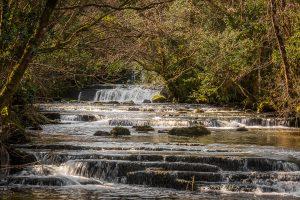 From here a quieter, smaller road is journeyed on the R282 to Rossinver. Another flat land cycle over peaceful countryside with the Dough mountains on your right and the Base of Cope's mountain to your left. It takes around 10 mins (11km.) to reach the village and about 10 mins (2km) further to reach our destination, Fowley's Falls. This it not so much a falls (a single descent) as a number of consecutive descending levels, like rapids and it is also one of the best kept "hidden gem" secrets in Ireland. Get there quickly before that all changes.
From here a quieter, smaller road is journeyed on the R282 to Rossinver. Another flat land cycle over peaceful countryside with the Dough mountains on your right and the Base of Cope's mountain to your left. It takes around 10 mins (11km.) to reach the village and about 10 mins (2km) further to reach our destination, Fowley's Falls. This it not so much a falls (a single descent) as a number of consecutive descending levels, like rapids and it is also one of the best kept "hidden gem" secrets in Ireland. Get there quickly before that all changes.
Is there a better way to experience the landscape of a country than exploring what is on offer, at your leisure, by bicycle. This way it is possible to plan the route that takes you to the areas of your choice while stopping to explore previously unknown, off the beaten track, gems that very often turn out to be the highlight of your holiday. The treat, that awaits the explorer who allows their mind drift off on a cloud of reverie that comes naturally to children, is ready to make this day a never-to -be - forgotten one.
A world, forgotten by most adults beckons the lucky ones who allow themselves return to younger times, when their greatest worries revolved around how to trick a Leprechaun into handing over the pot of gold or whether fairies and dragon flies were the same thing.
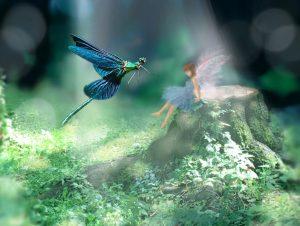 Have you ever been momentarily transported for a nano-second, or hopefully longer, who knows, from where you are standing (not unlike Scotty beaming you up) to glimpse a long forgotten memory or thought, perhaps a veiled reminiscence, reaching for a pleasant longing that's just beyond your fingertips and is floating away from you. During that second a colourful speck catches the corner of your eye and immediately brings you back to the now. An adult will think it was a dragon fly, a child will know it was a fairy.
Have you ever been momentarily transported for a nano-second, or hopefully longer, who knows, from where you are standing (not unlike Scotty beaming you up) to glimpse a long forgotten memory or thought, perhaps a veiled reminiscence, reaching for a pleasant longing that's just beyond your fingertips and is floating away from you. During that second a colourful speck catches the corner of your eye and immediately brings you back to the now. An adult will think it was a dragon fly, a child will know it was a fairy.
Fowley's Falls is a place where it is easy to gaze at the cascading water and return to your earlier spirit of imaginative reality.
The mind of a child is pure, free and open to everything that surrounds them, full of wonder, questions and absolute insatiable curiosity. It has not yet been taught education for life, by us, the good guys (instruction) nor taught education for life, by them, the bad guys (radicalisation).
Fowley's Falls is not anything like the great rapids of the world but it can transport you to the Land of Wonder and Imagination if you open yourself to the sound, sights, smell and colour that will compel a person to open all their senses - to the most unintrusive doctrine possible – that of the wonder of a child.
Yeats is the only one who came close to unravelling such wonder, but he was blessed by the instruction of the ancestors of the Fir Shidh, the Sioga - or was he? Was it that he found the secret of how to let the cares of the world disintegrate?
Join him. Find out. Indulge your senses.
With picnic tables and seats and no one around to bother you perhaps you could squeeze another half hour out of your time for a picnic.
From here, refreshed, we head back to Rosinver, turning north onto the R282 and travelling up this road to the R281, a journey over a relatively flat quiet road that rises enough to give a rewarding view over Lough Melvin on your right, the first half of the cycle to Kinlough. A cup of tea or coffee might be in order in the Courthouse restaurant before turning south again, should a picnic not have been your fancy at the falls, because there is no-where else before reaching Manorhamilton.
Next to the R280, for a foray into part of the ancient world that existed before the Celtic tribes ever discovered the fact that Guinness originated in Black Lake. (That woke you up!) This is a relatively easy cycle, flatland with a gentle rise, with the Arroo Mountains and then Keeloges to your left and Tievebaun Mountains to your right.
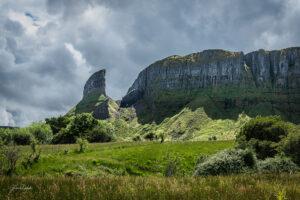 If the cycle distance is getting to you a little, reach into the reserves for Eagles Rock, yet another lesser known gem, not far from here. To get there, turn right onto the L6100 (opposite a cemetery) and take the first left (immediately after the bridge). This is a looped road which will bring you to where Eagles Rock stands 330m high, looking down at you.
If the cycle distance is getting to you a little, reach into the reserves for Eagles Rock, yet another lesser known gem, not far from here. To get there, turn right onto the L6100 (opposite a cemetery) and take the first left (immediately after the bridge). This is a looped road which will bring you to where Eagles Rock stands 330m high, looking down at you.
Cycling in the rock's direction, you reach a small car park which has an information board but unless you are extremely fit I would not attempt the ascent and, walk you must, leaving your rented bicycle chained up, as it is not an easy climb and by now you must be feeling today's efforts. It is definitely worth a visit another day.
The Cailleach and Eagles Rock
At this stage of our existence it is obvious, to me anyway, that the world is in the midst of a traumatic Climate Change, or not, as you wish to believe. I will wager, however, that it never occurred to you, just what the cause of the climatic disaster really is.
In a word it is the Cailleach, and on another trip you should enter Her domain.
Before the Celts arrived, even a long time before the Tuatha De Dannan's rule in Ireland commenced, the land around gifted Her with one of Her favourite resting places, to design as She desired. She paid particular attention to the col between the rock and the mountain which She detached from the mountain and then amused Herself leaping from rock to mountain while scattering rock pillars.
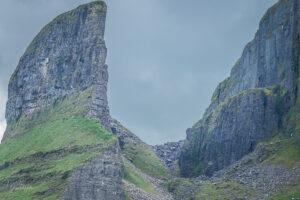 In an Indiana Jones movie you will have seen the ruins of ancient civilizations, overgrown images of half broken granite statues, marble fragmented pillars, walls and nature reclaimed mosiac courtyards of once mighty empires.
In an Indiana Jones movie you will have seen the ruins of ancient civilizations, overgrown images of half broken granite statues, marble fragmented pillars, walls and nature reclaimed mosiac courtyards of once mighty empires.
Here is a combination of one part moon surface, one part Morder after the fires went out and the last part a wild cacophony of quartz metamorphosed sandstone in a disarray of anarchistic design, which includes a wall of raw cliffs, created with the help of a monster storm of Her making, during a fit of manic rage. Peculiarly, there is no overgrown grasses, trees or vines here, just an eerie possible resting place for Herself.
Astoundingly, the views of Her garden, Glenade lake and valley below, is of such placid and perfectly balanced natural beauty it was deemed an area of special conservation in 1977, while to the north can be seen Donegal's Slieve League and across the summit, the plateau of Arroo Mountain.
Tear yourself away from the lady's resting place and back on the road to Manorhamilton from where we head back to the car in Sligo, thoroughly exhausted but exhilarated
Yes, No?
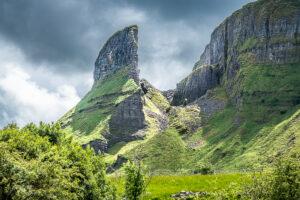 I call this trip the Glencar Cycle Route but in fact it goes much further than that, taking in Manorhamilton, Fowley’s Falls, Lough Melvin, Kinlough and Eagles Rock. It takes about 6 hrs to do (95 km) and that’s without stopping for photos, refreshment or simply re-charging the batteries with the exquisite works of nature.
I call this trip the Glencar Cycle Route but in fact it goes much further than that, taking in Manorhamilton, Fowley’s Falls, Lough Melvin, Kinlough and Eagles Rock. It takes about 6 hrs to do (95 km) and that’s without stopping for photos, refreshment or simply re-charging the batteries with the exquisite works of nature. We depart Sligo town on the N16 towards Benbulbin, the proudest mountain of the Dartry range, for 14 km to reach Glencar Waterfall. If it has been raining, the highest falls in Ireland, Sruth in Aghaidh an Ard (the Devil’s Chimney) is only a stone’s throw away. The panoramic views all around of Glencar Lake and mountainous background, not to mention the relaxing coffee shop could be enough to keep you for an hour or two.
We depart Sligo town on the N16 towards Benbulbin, the proudest mountain of the Dartry range, for 14 km to reach Glencar Waterfall. If it has been raining, the highest falls in Ireland, Sruth in Aghaidh an Ard (the Devil’s Chimney) is only a stone’s throw away. The panoramic views all around of Glencar Lake and mountainous background, not to mention the relaxing coffee shop could be enough to keep you for an hour or two.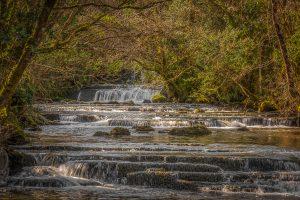 Favourite location? Fowley’s Falls is one of mine. This section of our day out is a 10 km trail and is a pure secret gem – for now anyway. Take your time here, bring a picnic, indulge yourself your on holiday.
Favourite location? Fowley’s Falls is one of mine. This section of our day out is a 10 km trail and is a pure secret gem – for now anyway. Take your time here, bring a picnic, indulge yourself your on holiday.
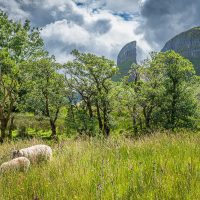
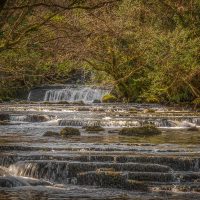
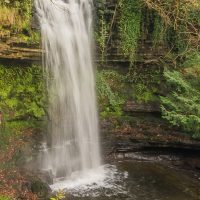
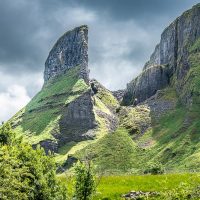
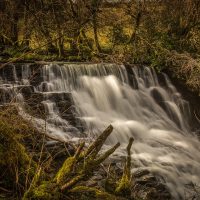
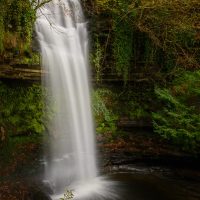

 From here a quieter, smaller road is journeyed on the R282 to Rossinver. Another flat land cycle over peaceful countryside with the Dough mountains on your right and the Base of Cope's mountain to your left. It takes around 10 mins (11km.) to reach the village and about 10 mins (2km) further to reach our destination,
From here a quieter, smaller road is journeyed on the R282 to Rossinver. Another flat land cycle over peaceful countryside with the Dough mountains on your right and the Base of Cope's mountain to your left. It takes around 10 mins (11km.) to reach the village and about 10 mins (2km) further to reach our destination,  Have you ever been momentarily transported for a nano-second, or hopefully longer, who knows, from where you are standing (not unlike Scotty beaming you up) to glimpse a long forgotten memory or thought, perhaps a veiled reminiscence, reaching for a pleasant longing that's just beyond your fingertips and is floating away from you. During that second a colourful speck catches the corner of your eye and immediately brings you back to the now. An adult will think it was a dragon fly, a child will know it was a fairy.
Have you ever been momentarily transported for a nano-second, or hopefully longer, who knows, from where you are standing (not unlike Scotty beaming you up) to glimpse a long forgotten memory or thought, perhaps a veiled reminiscence, reaching for a pleasant longing that's just beyond your fingertips and is floating away from you. During that second a colourful speck catches the corner of your eye and immediately brings you back to the now. An adult will think it was a dragon fly, a child will know it was a fairy. If the cycle distance is getting to you a little, reach into the reserves for Eagles Rock, yet another lesser known gem, not far from here. To get there, turn right onto the L6100 (opposite a cemetery) and take the first left (immediately after the bridge). This is a looped road which will bring you to where Eagles Rock stands 330m high, looking down at you.
If the cycle distance is getting to you a little, reach into the reserves for Eagles Rock, yet another lesser known gem, not far from here. To get there, turn right onto the L6100 (opposite a cemetery) and take the first left (immediately after the bridge). This is a looped road which will bring you to where Eagles Rock stands 330m high, looking down at you. In an Indiana Jones movie you will have seen the ruins of ancient civilizations, overgrown images of half broken granite statues, marble fragmented pillars, walls and nature reclaimed mosiac courtyards of once mighty empires.
In an Indiana Jones movie you will have seen the ruins of ancient civilizations, overgrown images of half broken granite statues, marble fragmented pillars, walls and nature reclaimed mosiac courtyards of once mighty empires.